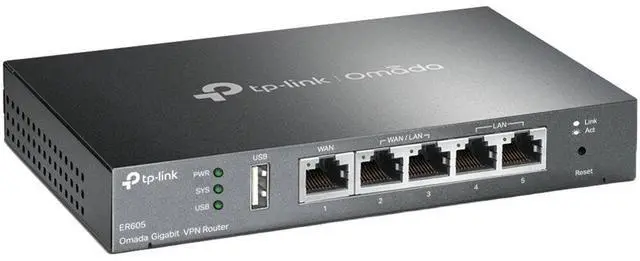Secure your business network with the ER605 V2 Omada Gigabit VPN Router from TP-Link. Designed for high flexibility, this VPN router features five Gigabit Ethernet ports, two of which can be freely switched between WAN and LAN modes and work alongside the dedicated WAN and two LAN ports to manage multiple internet connections through one device. With the multi-WAN Load Balancing function, data streams are distributed according to the bandwidth proportion of every connected WAN port to optimize multi-line broadband utilization. A mobile 4G/3G broadband modem may be connected to the router through the USB 2.0 port as a backup WAN connection.
The ER605 V2 also provides comprehensive security coverage with IPSec, PPTP, and L2TP VPN support over the IPSec/SSL protocols in addition to VLAN support and advanced firewall policies. The IPsec VPN has a maximum throughput of 248.04 Mb/s with the ESP-SHA2-AES256 authentication and encryption algorithm. Additionally, the device can handle up to 150, 000 concurrent sessions. Use the Omada app alongside a separately purchased controller to configure your ER605 V2 VPN router and other compatible network devices from almost anywhere, at any time. The ER605 V2 VPN router features five Gigabit Ethernet ports comprised of two fixed LAN, one dedicated WAN, and two WAN/LAN ports.
The multi-WAN Load Balancing function distributes data streams according to the bandwidth proportion of every WAN port, raising the utilization rate of multi-line broadband. Integrating your gateway into the Omada Software Defined Networking (SDN) platform allows you to manage your entire network from different sites from anywhere, anytime via the web interface or Omada app. An Omada hardware, software, or cloud-based controller is required. Administrators can moderate users' online behavior and specify employees' internet access rights and strategies via IP/MAC/URL Filtering and Access Control List (ACL). Captive Portal authentication facilitates network resource control by capturing, authenticating, and classifying user access.
Appropriate network resources can also be allocated for particular users or guests
